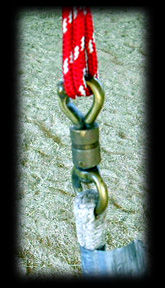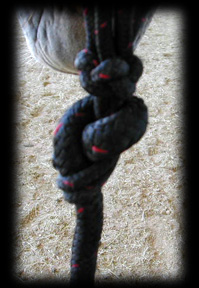|
Rope Halters
the Good, the Bad and the Ugly
I love my rope halter, don't get me wrong......but there is a time and place for everything - that includes my rope halter.
I like them because they are light on a horse, but strong when needed. I could not get along without at least 14 ft.
of lead rope either! The yacht rope feels good in my hands and they are extremely durable.
Everyone should learn to ride with one rein and every horse needs to learn to be ridden in one rein. It stops people
from their bad habit of pulling and helps seperate each corner of the horse by isolating the rein responsibilities: direct,
indirect and supporting. Teaches both horse and rider the difference between control and communication.

|
| Lead Rope with Snap |
There are a few concerns though. The first being the rope halters with clips/snaps to attach them to the halter. I think
it is too much weight and has too much movement once the horse is in motion. Second, when used improperly, the buckle can
cause alot of pain when jerked and yanked around under the horses' face. It causes them to throw their head up and away from
that annoying and painful rude behavior people inflict on them, which is exactly the opposite of what one is trying to accomplish.
I have also seen snaps break and come flying back at the person on the other end of that rope - not pretty.
Any movement or pressure under the chin will cause the head to elevate. While the horse will soon adjust to this, it will
depend on how much the student improves on their rope handling skills to the degree in which this issue can remain. This
also depends on how the lead is attached to the halter. The clip or snap will be heavier than plain rope, plus have a quicker
tendancy toward movement and exaggeration of such. While some duller horses can benefit from this, a more sensitive horse
will over-react and this can take away from any lessons you are trying to accomplish.

|
| Lead Rope with Knot |

|
| Lead Rope with Splice |
The plain rope attached seems to be a better deal, but really, it is unblanced in the way of attachment. The knot cannot
be balanced from side to side and will have a tendancy to hang in one direction more than the other......an offset of weight
distribution. Really, the best I have found so far would be a looped rope with a good balanced splice in it for evenness
from left to right and front to back.
The biggest problem with the rope halters, is that it causes improper flexion of the head, jaw and poll when the horse
is worked on the ground or ridden. This is the beggining of many problems that are hard to eradicate once you are working
toward correctness.
As you take hold of the lead, the pressure starts from under the chin where the knot is. As the knot pulls toward you, the
pressure continues up the outside of the face to the knot on the top of the nose. The natural reaction of the horse will
be to brace (the outside jaw and poll) agaist this uneven pressure. This can develop into a habit of turning the head to
the outside and dropping the inside shoulder (further stiffening the rib cage and bringing the hip in). A crooked horse.
After many sessions of teaching a horse to "give" to the pressure (see article on Over-Flexing), the next thing
that happens is though the horse may not be pulling, the flexion of the head, jaw and poll will most likely be incorrect.
The horse may tip his forehead to the outside, thereby creating an even pressure across the nose, but tension on the inside
of the neck and jaw. The horse may tip only the nose to the inside, while allowing uneven pressure on the nose and under
the chin. This will cause tension in the poll and inside jaw. They may also break at the base of the neck to alieve pressure.
The horse may also over compensate and tip his forehead to the inside; agian creating pressure in the neck, poll and jaw.
This will all depend on the obedience of the horse and the hands of the human. The knot ideally should be hanging straight
under the horses' chin while working - but this takes eduation on both parts.
While riding with one rein there are a whole 'nuther slew of issues that come up with the rope halter. Consider again, where
the lead attaches under the horses' chin. Any pressure will naturally cause the nose to respond in a vertical movement.
It will be pushing agianst pressure and again throwing the head up; getting stiff and sucking the head into the neck and the
neck into the shoulder or overflexing and bringing the chin to the neck - or various combinations thereof.
When sliding down the rein, many students are sliding down the neck instead of out and away. The former further brings
backward motion of the head, neck, weight distribution and hinderence of movement. It quickly locks up forward motion of
the horse and develops braces that hinder progression very rapidly.
To slide down correctly, ones hand must come in a forward and outward arch away from the horses' neck. The riders shoulder
holds up the whole arm and rein - which means there is no tension below the shoulder (except once you close your fingers and
hold, but the tension remains only in the hand). Your hand should hover minimally over your knee on that same side. This
will cause the horses' neck to extend forward and the nose to tip to the inside. (For further reading on correct flexing,
see Over-flexing article)
Even when we do slide correctly, we still have the same issues that came up in the ground work with unbalance and improper
flexing because the rein comes from under the chin. Ideally, the pressure should come from the side of the horses' face
as if he where wearing a snaffle. Only this can promote a better form of balance and correctness in lateral flexing.
My answer to this is to not ride in that halter too long....and NEVER ride in one of those rope "hackmores"!
While you are riding in your halter though, learn the proper lateral flexion and the warning signs of issues to soon arise.
In the following articles, you will read about some alternatives to the ground work and riding: Lariat and Neck Rope Work;
Riding in a Cavesson.
(picts to come...)
|

